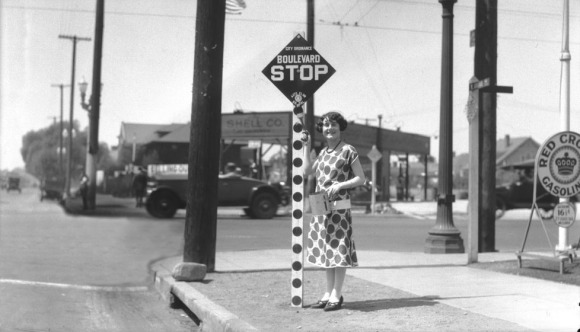Stop, look, and listen. Stop, drop, and roll. Stop in the name of love. No matter how or where it is used, you know what to do when you see that red octagon emblazoned with bold white letters that spell out S-T-O-P. We wanted to learn about the origin of this international symbol and share our findings with you this week as we continue our series on visual communications. Road signs are all around us. But have you ever thought about their color, shape, or height? The design of these forms of visual communications are thoughtfully planned. The stop sign originated in Michigan, the state home to the motor city Detroit, where else? It turns 100 next year. The first stop signs looked much different than those we have today. They were originally 24 x 24 inches with black lettering on a white background. To get to the design we know today wasn’t easy and didn’t happen overnight.

One of the first stop signs installed in Los Angeles, circa 1925
(Credit: USC Libraries)
In the 1920s, not all stop signs looked alike which could cause driver confusion. So, in 1922 the American Association of State Highway and Transportation Officials (AASHTO) decided that stop signs should be standardized. The octagonal shape was selected as it allowed drivers facing the back of the sign to identify it and know that oncoming drivers will be required to stop. Another reason for the octagonal design was so it could be more easily identified at night as the original stop signs were not reflective. AASHO later merged with its main competitor, the National Conference on Street and Highway Safety (NCSHS) to form the Joint Committee on Uniform Traffic Control Devices. In 1935 this new committee published the first Manual on Uniform Traffic Control Devices (MUTCD) creating the official specifications for the stop sign. Previously NCSHS had wanted the stop sign to be a smaller pink-on-yellow sign. Nearly twenty years later in 1954, the white lettering on a red background was selected for the stop sign. Red was used because it already signified a stop on traffic lights. This decision unified the color red as a requirement for motorists to stop whether they saw it approaching a sign or traffic light. While the MUTCD stop sign we know today was widely used throughout the United States after its standardization, it didn’t became a law for motorists until 1966.

Collection of STOP signs from the 1920’s through 1950’s Credit: myparkingsign.com
But the history of the stop sign doesn’t STOP here. It went global. The MUTCD stop sign came under international consideration during the Vienna Convention on Road Signs and Signals in 1968 as part of the effort to to increase safety by standardizing road traffic signage. The convention was agreed to by the United Nations Economic Commission and Social Council at its conference on Road Traffic that same year. The convention produced a treaty that specified ‘stop’ should be written in English or the country’s national language. A yellow circular sign was also determined to be an acceptable alternative to the standard stop sign at the convention.

Various international stop signs, each with STOP written in English or the country’s national language
(Credit: roadtrafficsigns.com)
The stop sign we know and use today has come a long way since its beginnings in Michigan. In fact, it represents one thing the international community agrees on. It shows even the visual communications we take for granted may have undergone an intricate design process. Do you have a favorite piece of signage? Feel free to share it with us and any history you may know about it.
The Collaborative Services Blog Team

Recent Comments